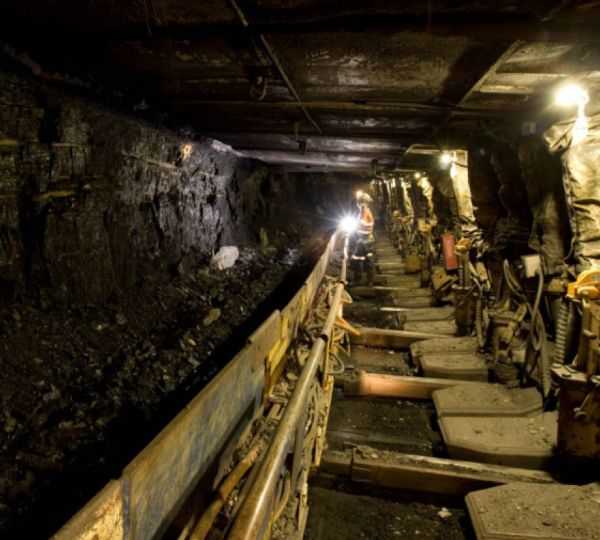Mining Feature: NIOSH Mining Webinar: Improvement of Longwall Ventilation
Friday, May 12, 2017
The NIOSH Mining Program will host a webinar Sept. 21, 2017, at 1 p.m. EDT, on the subject of: Improvement of Longwall Ventilation.
You can join by Skype on the day of the event.
This webinar will feature four presentations.
Various aspects of longwall ventilation research will be covered, including field studies, physical and numerical modeling, and an evaluation of a methane monitor.

An active longwall operation
Field Studies
NIOSH researchers designed a series of field studies to investigate longwall face airflow and possible exchanges with the gob. With changing face lengths and caving characteristics, these factors are important to consider. As safe concentrations of gas must be maintained and these pathways were not part of the ventilation design, these concerns could be relevant to gas monitoring on the face. Field data show that pathways of movement exist both on the longwall face and in the vicinity of the shield legs. Evidence of these pathways of movement will be given and the effects of differing mining and ventilation plans on face air movement and face-gob air exchanges will be demonstrated.
LIAM
NIOSH staff constructed a 1:30 scale model of a longwall mining operation in a building on the Pittsburgh Mining Research Division campus to simulate airflow in a longwall panel. The Longwall Instrumented Aerodynamic Model (LIAM) was built to maintain critical details of the face and mining machinery. The LIAM’s development and scaling will be discussed along with ventilation simulations involving various roof caving scenarios behind the shields for bleeder and bleederless setups.
Numerical modeling
NIOSH researchers developed numerical simulations of air movement and pathways to investigate transport characteristics on the longwall face and in the active panel gob. Two numerical models were created: The first uses a discrete fracture network (DFN) model of reservoir transport longwall gobs. This DFN model produces a more accurate representation of gas movement through rock fractures instead of averaged movement throughout gob rubble. The DFN model output was linked to a ventilation model using computational fluid dynamics (CFD) to generate an image of gas movement from the gob, onto the face and in ventilation air. The second is a CFD model developed to show gob and face air movement in the LIAM, NIOSH’s physical model for ventilation experiments. This second model shows how airflow changes throughout the LIAM with different mining and ventilation configurations. Model comparisons with field data and LIAM simulations will be discussed.
Fiber optic methane monitor
A remote fiber optic methane monitor developed under a NIOSH contract provides capabilities that may be useful for continued operation after initial fires or explosions. NIOSH researchers conducted experiments to evaluate a prototype fiber optic methane monitor exposed to smoke using a smoke chamber to simulate atmospheric conditions in an underground coal mine after a fire or explosion. The experiments used test fires of different combustible sources commonly found in mines — Douglas-fir wood, SBR belt, and Pittsburgh seam coal. The potential for using the monitor after an initial fire or explosion and the impact of smoke on optical signal losses and soot accumulation on a protective sensor screen will be discussed.
For more information, email Tom Dubaniewicz, or call him at 412-386-6596.
See Also
- Artificial Neural Networks to Determine Ventilation Emissions and Optimum Degasification Strategies for Longwall Mines
- Degasification System Selection for U.S. Longwall Mines Using an Expert Classification System
- Development and Application of Reservoir Models and Artificial Neural Networks for Optimizing Ventilation Air Requirements in Development Mining of Coal Seams
- Evaluation of the Relative Importance of Coalbed Reservoir Parameters for Prediction of Methane Inflow Rates During Mining of Longwall Development Entries
- Field Study of Longwall Coal Mine Ventilation and Bleeder Performance
- Investigation into the Practical Use of Belt Air at US Longwall Operations
- MCP - Methane Control and Prediction - 2.0
- Modeling and Prediction of Ventilation Methane Emissions of U.S. Longwall Mines Using Supervised Artificial Neural Networks
- A New Methane Control and Prediction Software Suite for Longwall Mines
- Prediction of Porosity and Permeability of Caved Zone in Longwall Gobs
- Page last reviewed: 9/18/2017
- Page last updated: 5/12/2017
- Content source: National Institute for Occupational Safety and Health, Mining Program


 ShareCompartir
ShareCompartir